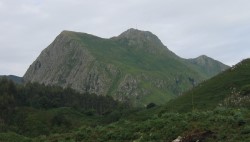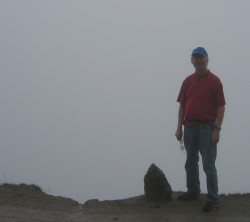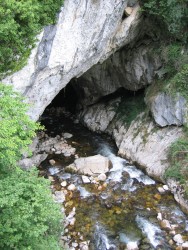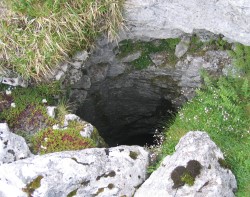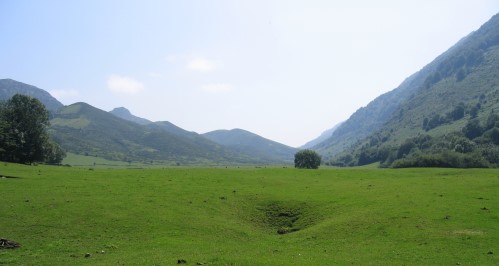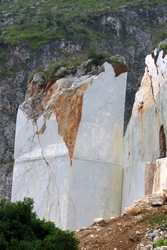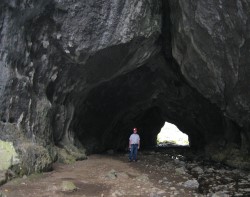

Introduction
Site list (GPS fixes) Walks (GPS tracks) Video clips Panoramas
Electronic projects:
Bat detector
Lamp tests
µ-controlled lamp
SEPIC-based lamp
ISP isolators
Making SMT boards
Expedition logs:
Spain 1973, 1974,
1975, 1976, 1977,
1979, 1982, 1983,
1985, 1986, 1987,
1988, 1989, 2000,
2001, 2002, 2003,
2004, 2005, 2006,
2007, 2008, 2009,
2010, 2011, 2012,
2013, 2014, 2015,
2016, 2017, 2018,
2019, 2020, 2021,
2022, 2023
Mexico
New England
Translation:
Expedition log, Summer 2006
Gesaltza, Viango, Forcau, Devoyu, Ramales, Balzola, etc.
| Date |
Activity |
|---|---|
| 23.06 | 05:30 start for both, to catch flights
(BGY→BIO, BHX→DUS→BIO). One is reminded how pleasant Dusseldorf
airport is, compared to some.
Bill arrives at Bilbao without missing any flights at 11:25 and spends 30 minutes queuing at the Atesa Car Hire counter. Delays caused by computer failure! A visit to the airport tourist office provided a free booklet on the National Parks near Bilbao and it was clear that some contained caves. When Mike arrived at 13:22 we quickly agreed that a visit south of Oñati would be worthwhile and we got there via a round-about route through the Urkiola National Park. A 10 minute walk brought us to a major sink, Cueva Gesaltza, which offers a spectacular 70m abseil-practice pitch from the cliff above for anyone so inclined. Being equipped only with cameras and headlamps (no helmets or other caving gear) we nevertheless penetrated an estimated 200m of boulder-strewn gently descending passage before halting at the top of a pitch. The pitch consisted of a possibly free-climbable 3m drop onto a landing followed by a further 5m drop (probably overhanging) to continuing dry streamway. The local landowner confirmed the name of the cave and told us the 3km system connects to the resurgence, which is now being converted into a show cave. Following the landowner’s directions we drove up to the Santuario de Arantzazu but in the hot sunshine the steep descent to the valley bottom on foot seemed unwise. Instead, we found a route that allowed us to drive there via a very long track (about 6km). At the confluence of two valleys below the Sanctuary, we found a strongly drafting resurgence system which Bill entered for 3m! 200m downstream is another cave on the south side of the valley; this one had a screened entrance with a circular hole in it (probably for bats). 10m downstream were further entrances leading to 50m of walking passage and a free-climbable 3m pitch (not descended). Another 200m down-valley over a bridge was a remarkable spring shooting water out from numerous crevices. Alas there was no admittance to the show cave (still under construction) and we continued to Castro Urdiales arriving at Hotel Vista Alegre at 20:45. Then into the town for four-course menù (relatively expensive, at €57 for two). |
| 24.06 | Saturday. Rain overnight which restarted again at 10 am, so we decided to make it a travelling day, heading west for Asturias. The first stop was La Borbolla for a drive up a partially cemented track (discovered from aerial photographs before arrival) to the west of La Borbolla village to a series of major depressions. Falling water could be heard at the bottom of two of them but the drizzle and the wet descent through gorse and bracken was put off until a dryer day. Lunch at Casa Poli (at Puertas de Vidiago) was followed by an investigation of the nearby sea caves (Bufones) and their amazing acoustics. Then on to the hotel in Llanes. Las Rocas had no record of the booking (confirmed in writing by both parties) but they found us 2 rooms on the ground floor anyway. Re-explored Llanes; dinner at Cabañón (must re-try the lomo al ajillo). |
| 25.06 | Sunday. The objective of the day was Piedra
Llabre, the peak (with radio masts) overlooking Alto de la Tornería
and El Biforco (Los Cabriteros). A pleasant 2km track, mostly grassy, took us
up the 200m to 679m with minimal effort; rewarded with fine views.
We strayed off the beaten track on the way down, with a bit of karst-hopping
to allow us to look down into the Green Sink depression. Also scrambled
over the mounds commanding the pass itself, and discovered ditches
which are very probably remnants of trenches from the defence of El Mazuco in 1937.
Stopped for refreshment in El Mazuco, then continued on to deliver photos (from 1975) to the Ruisanchez family in Villa. The door was opened by adolescents who called for their mother, Conchi. She in turn explained that her husband Angel was in El Mazuco and we should have arrived the day before when his sisters Neri and Pili (and their families) were present for the Fiesta the day before (24 June, Fiesta de San Juan). On to Mestas for lunch (where we ate in 2005) – Verdinas (green bean stew) and Cabrales. A short diversion up the purported Roman Road in Riocaliente, then on to Riensena and up a track west towards La Mujerina, where a number of depressions appear on the map. Left the car at about +440m and carried on by foot. Radios proved useful as Bill carried out a thorough exploration of the first three medium-size depressions. Then on to the big depression at N43°23'56" W5°02'05" which had a promising 10m pothole at the bottom but no enterable cave. By now it had started to rain; we spoke briefly to a shepherdess who waved vaguely at where there might be a cave up-slope, but we found nothing. Back down to the car, well satisfied by two 2–3 hour walks in the day. Dinner at the fish restaurant (La Marina) in the Llanes harbour. |
| 26.06 | Monday. Heavy rain overnight. After
a brief stop at the map shop for a new Porrúa map, off east
to La Hermida. First a check on progress at the old Spa – refurbishment
now well under way. Then up to Bejes. An ‘interesting’ diversion
through the village due to road-building, then up the road to Treviso
until the way on was blocked by more road-building.
We continued on foot in mist and drizzle to Fuenté de Lobos, more
for the walk than in hope of finding anything speleological in the
cloud.
Back to the car and down to La Hermida Restaurante Paquin, very busy with construction workers from the Spa. Traditional paella (tasty, with the usual bits of chicken bone), followed by gammon. After lunch, down-valley and then up a road west of Panes to Rodriguero and Bores. Explored various tracks and woods to see if we could find anything speleologically related to the vauclusian resurgence in the gorge below. Nothing exciting, so back to Llanes; dinner of setas con picón and cocidillas (Boletus mushrooms and ribs) at El Almacén, the Sidrería near the tourist-office tower. |
| 27.06 | Tuesday. It stayed dry overnight, so back
to the depressions west of La Borbolla. First to the top depression
(at N43°21'44" W4°40'03") – a collection of minor depressions
at the bottom, no water now. The second depression (El Jorcón
📌), was scoured by Bill with similar results.
Determined to complete the reconnaissance, we followed a ‘cow motorway’
down to the third large depression 📌, covered
with the aid of radios, etc. A minor success; Mike finds a strongly
draughting cave (across the wall, near the lowest point), at least
5m long or more, but with entrance blocked by boulders which would
need crowbars or chemical persuasion to move.
After the long trudge back up the hill to the car, we are ready for lunch. Plan A was Casa Poli, but we end up at Sidreria El Candal, the bar outside Purón village, for excellent fabada. After lunch we explore the complicated water courses and mill-races west of the village and follow the track past Cueva El Cuelebre (by the stream). We turn back when we run out of limestone, but then notice caves in the cliff north of the river; the first of these is a short (40m) but classic dry rift through-trip. Bill reaches a higher entrance by means of an exposed traverse above a wasp’s nest, but it turns out to be just 5m long. Back to El Cuelebre itself for a muddy splash-about in the streamway before calling it a day. Back to Llanes via La Ballota beach (very crowded – three other people were seen) and Cue. Dinner again at Sidrería El Almacén – pollo con ajillo and pescado fritos (pixin, bacalau, and merluza pieces a la romana – in batter). The streets of Llanes are eerily deserted from 9pm for a World Cup match (Spain vs. France), except where the bars overflow onto the pavement. At 10:50 the bars empty in minutes, too, after Spain loses the match. |
| 28.06 | Wednesday. Low cloud again, so head west
to Gijón. Nothing we planned to visit was open, so we make a loop
south towards Oviedo then SW up the Río Nalón valley. Stop at
the Tarna Hydroelectric plant to investigate caves, including one
8m long. Then a few more kilometres up the valley to Cueva Devoyu (de Bollo/de Boyu)
– an impressive cave taking the entire river; a must-do for a future
trip. Both entrances are approached from the old road which has
now been bypassed by a modern road tunnel.
Then north via Las Cuevas to Infiesto for 33km along a speleologically disappointing road, with not even the view at the pass making up for the hard driving and depressingly deep valleys (investigated by OUCC in 1974). Lunch at Infiesto (chuletinas [sic] and merluza a la romana) brightened us up, and we returned to Gijón to visit bar Buenos Aires, visit map shops, and walk around the town. Back to Llanes by 7pm; a 360km round trip. Dinner in Uría followed by Rioja and above-average Manchego (Ojos del Guadiana) in El Cuera Sidrería. |
| 29.06 | Thursday. Clouds have lifted; it’s time
for the 30th anniversary trip to Forcau – almost to the day (the
first rigging trip in 1976
was 1st July).
We get to the car park at the lakes at about 11:35, where the mountains are still partly in cloud, and head south from Lago Ercina. Bill investigates two possible entrances at N43°15'36" W4°58'44", +1235m, but neither go. Mike similarly checks a 5m vertical through trip at N43°15'27" W4°58'28", +1306m, but no way on. Crossed the spectacular Vega El Paré and up to the cabañas below the last steep bit; here we first carried on south a few hundred metres to look down into the depression beyond, and then up to the El Forcau pass and past the stone pens to Pozu del Vega El Forcau. Arrived 13:15 (the 1:40 time for the walk, including side explorations and visiting the southerly depression, compares very favourably with the 1:15 best time recorded in the 1976 log).The Pozu itself was, as always, a bit tricky to find. From the small ‘peak’ in the middle of the valley (≈200m at 210° from the pass) the cave is underneath a brown stone outcrop at 220°, perhaps 200m from the peak. On the way down, Bill tightens his bootlace and it breaks, leaving a piece 50cm long. “I’ll keep that for prusiking!”, he declares... An otherwise uneventful but satisfying descent gets us back to the car park at 15:00. Lunch at the Lago Ercina Bar María Rosa; Chicken noodle soup and an above-average carne guisado (pot roast); €10 each. We then explore the depression east of the carpark for an hour, but find only springs and a choked sink (and a mine). Back to Llanes for dinner at La Marina – excellent Xiaragu (Bream) followed at El Cuera by Manchego and walnuts. |
| 30.06 | Friday The first patches of blue skies
in the area inspired us to retry the walk to the Yosa de Viango from
the west with the object of searching for caves on the north side
of the Yosa as described by Pedro at Purón Verde. We parked near
the end of the road 📌 south and above Alto
de la Tornería and after wasting 20 minutes on a false start we
set off again from the end of the road at 10:40, first left and down
to a cabin and then contouring around the west end of the nearby
hillock (going SSW at one point) before descending WSW into the valley
along a fair but tedious cow path. By this time cloud was covering
the mountain peaks. Approaching the Yosa we descended to a small
streamway coming from a dammed spring
📌. This route required subsequent manoeuvering
over stone walls and barbed wire which we could have avoided by staying
on the higher cow path. Arrived at the open Yosa at 12:00.
The Yosa was populated with the usual cows and horses of all ages – some of which were cantering round the flat meadow. The route round the north side finally took us up a narrow valley 📌 with a dry streamway. However as this was in sandstone, we did not expect to find any cave (though there is the possibility of a resurgence high above) and we were leaving the Yosa behind us. On descending, we verified that most of the north east side of the Yosa is also sandstone. Disappointed but satisfied with the views and fast pace of the inwards walk (1 hour 40 minutes) we retraced our steps but inadvertantly followed a cow path too far to the north and ended up near the depressions east of the road, as in 2001. This time visibility (and the map) was much better and the GPS and cow paths brought us to within 10m of the car, with little or no lost time – left the Yosa at 13:00, back to car at 14:35. We drove down 1km to El Roxin, the El Mazuco bar/restaurant for an urgent beer and a hearty lunch of chuletillas and lomo, followed by a postprandial one-hour stroll above La Boriza. Returning to Llanes via the inland route, we stopped at Rales and invited Tony for a drink. María, Juanjo’s wife, and daughter also recognized us and said hello; we were told that Antonio and Mari Nieves would be arriving the next day (Saturday). El Retiro for dinner. |
| 01.07 | Saturday. First day of hot sun in Asturias
(31°C). West to Riensena to check side roads noted earlier 25.06,
went to end of the road visited some years earlier (1989), but nothing
found. Back east to Arenas to take some pictures of the Cares valley,
etc., then GPS Flea Cave 📌.
Lunch at El Sucón restaurante. Delivered Rales cave survey to Juanjo in Rales in the evening, and dinner (calamares en su tinta, merluza a la plancha) at La Marina. |
| 02.07 | Bill’s Birthday. Caving, of course, required.
So, by 10:30 we are up above Purón and soon down Pruneda. An enjoyable
trip to the start of the ‘wet bit’, followed by a slow exit checking
for overlooked side passages. Bill’s new 3W LED headlamp works well.
After exiting, we decide to check around the cabañas and depressions east of the cave. It’s just a warm day (22°C) but there’s little wind, and all a caver’s dislikes are concentrated in one small area: hawthorne, brambles, nettles, thistles, gorse, horseflies, and ensnaring cobwebs ... the latter sticking like glue to the sticky cavers. The depressions proved fruitless (though interesting drainage); the cliff face had a short rift cave, about 10m long, reached via an ‘interesting’ exposed traverse above a 300m drop at the head of the main valley. After an hour and a half of this we declare the area fully explored and retire to El Candal for a cold beer and a tasty light lunch (chorizo, gambas al ajillo, and patatas bravas). After lunch we walk up-valley beyond Purón Verde (which was closed) and note an interesting side stream valley with limestone cliffs, on the left bank. Returning by car we continue to the end of the road (fish farm) but see nothing speleological [ed: but see 2010 – we missed the resurgence!]; the side valley will have to wait until another year. Dinner in Sidrería El Almacén followed by Manchego in El Cuera (again). |
| 03.07 |
Monday; time to head east. Departed Llanes around 10:30; arrived
Ramales at noon, in less than half the time of just a few years ago.
After a walk around the older part of the town we headed for limestone
south of the town. First stop was Cueva Mirón; an active archaeological
dig for over a decade (and now down several metres from the current
surface) with discoveries dated back over 41,000 years. Above it
is Cueva Covalanas (gated and closed). Next we took a loop around
to the north via Concha (mostly sandstone) and found a Sidrería
for lunch nearby. Meeting the limestone again, now a little north
of Ramales, we tried to visit Cueva Pozulagua (also closed), and
saw and photographed a remarkable limestone block in a quarry.
Deciding there was little more to see in that area without more research, we headed for one of our original objectives, La Cueva de Balzola, southeast of Dima. These are two large passages taking a stream, with various side passages, explored by Bill in 2005. A new archaeological dig started that day in the lower cave; the digging team showed us a survey of the cave (which extends to about twice the length of the easily-accessible parts), and explained that they were trying to link the new dig to a Neanderthal site in a rock shelter 200m down-valley. By now it was after 19:00, so we drove back to Castro Urdiales to check in, followed by a good expedition dinner at the ‘last restaurant under the arches’ (anchoas, gambas al ajillo, and Manchego, washed down with Viñas del Vero »). |
| 04.07 | Tuesday – depart Castro at 9:30, at Bilbao airport by 10:15. The hot and sticky cattle pens of Frankfurt airport are a sharp contrast to the vegas in the mountains of the Picos de Europa. |
Personnel: Bill Collis & Mike Cowlishaw.
Notes:
- Exchange rate: 1.46; 68.5p = 1 Euro = 166 pesetas (242 pts/GBP).
- Weather: 2 days sunny, others cloudy and often humid; light rain overnight and in clouds.
- GPS (Garmin Geko 201), positions in °,′,″ shown using WGS84 datum.
- This log was edited in the field on an NEC 780 HPC, using the MemoWiki » extended Wiki notation which is then processed by a Rexx » script to generate the HTML for this web page. On return it was then copied to the Speleogroup Memowiki, from which a ‘static snapshot’ is directly published to the www.speleogroup.org » website.
